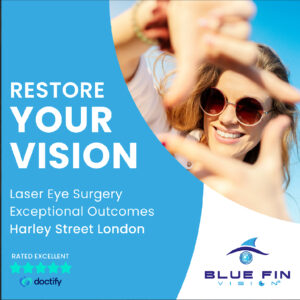Refractive Lens Exchange (RLE) is an advanced and highly effective vision correction procedure that has gained popularity, especially among older individuals. Unlike traditional vision correction surgeries like LASIK, which primarily focus on reshaping the cornea, RLE involves replacing the eye’s natural lens with a synthetic intraocular lens (IOL) to correct refractive errors and address age-related vision changes. It has proven to be an ideal solution for those who are not good candidates for laser-based procedures, particularly individuals over the age of 40 or those with complex visual issues, such as presbyopia, high degrees of refractive errors, or cataracts.

One of the main reasons RLE is so effective is that it directly addresses both the causes and symptoms of common refractive errors, including nearsightedness (myopia), farsightedness (hyperopia), and astigmatism, as well as presbyopia. As people age, their eyes gradually lose the ability to focus on close-up objects, a process that is inevitable for most individuals after their 40s. This can lead to the need for reading glasses or bifocals. RLE, however, offers a more permanent solution by replacing the eye’s natural lens with an IOL that is specifically designed to improve vision at multiple distances. For many patients, this means that they no longer need to rely on reading glasses or corrective lenses after the procedure.
Additionally, for patients who have developed cataracts—a condition that clouds the natural lens and causes blurred vision—RLE offers a dual benefit. It corrects the refractive error while also treating cataracts by replacing the damaged lens. In such cases, RLE eliminates the need for cataract surgery and provides an all-in-one solution that enhances vision quality and reduces reliance on glasses.
The procedure itself is relatively simple and is typically performed on an outpatient basis under local anesthesia. During the surgery, the surgeon makes a Refractive lens exchange small incision in the cornea and removes the natural lens. The new IOL is then inserted through the incision, which is so small that it often doesn’t require stitches. This makes the recovery process relatively quick and minimally invasive. Most patients can resume normal activities within a few days, although it may take a few weeks for the eye to fully heal and for the final results to become clear.
While RLE offers impressive results, it’s important for potential patients to consider a few factors before deciding if the procedure is right for them. The cost of RLE is typically higher than LASIK or other corrective surgeries, primarily due to the use of advanced technology and the customization of the IOLs to meet the individual needs of each patient. However, this investment can be worthwhile, particularly for individuals who are seeking a long-term solution to their vision problems.
Patients should also be aware that, although the procedure is generally very safe, there are some potential risks, such as infection, inflammation, or the development of posterior capsular opacification (a cloudy membrane behind the IOL). These complications are rare and can usually be treated successfully if they occur. Additionally, some individuals may experience visual disturbances such as glare or halos around lights, though these side effects typically subside as the eye heals and adjusts to the new lens.
For those considering RLE, it is crucial to have a thorough consultation with an experienced ophthalmologist to assess the health of the eyes, the type of lens that will be most suitable, and to discuss the potential risks and benefits. An ophthalmologist will evaluate factors like eye health, the degree of refractive error, and lifestyle requirements to help determine if RLE is the most appropriate solution.
RLE is particularly well-suited for patients over the age of 40 who want to improve their vision and reduce or eliminate their dependence on glasses or contact lenses. It is an especially attractive option for individuals with presbyopia or cataracts, as it not only addresses refractive errors but also offers an effective solution to age-related vision changes.
In conclusion, Refractive Lens Exchange is an excellent choice for many individuals seeking long-term relief from vision problems. Its ability to correct a variety of refractive issues while also addressing age-related changes such as presbyopia and cataracts makes it a versatile and highly effective solution. As the technology behind IOLs continues to advance, the outcomes of RLE are expected to improve even further, offering patients clearer, more natural vision and greater freedom from corrective eyewear. With careful consideration and expert guidance, RLE can be a life-changing procedure that helps individuals achieve enhanced vision and an improved quality of life for years to come.